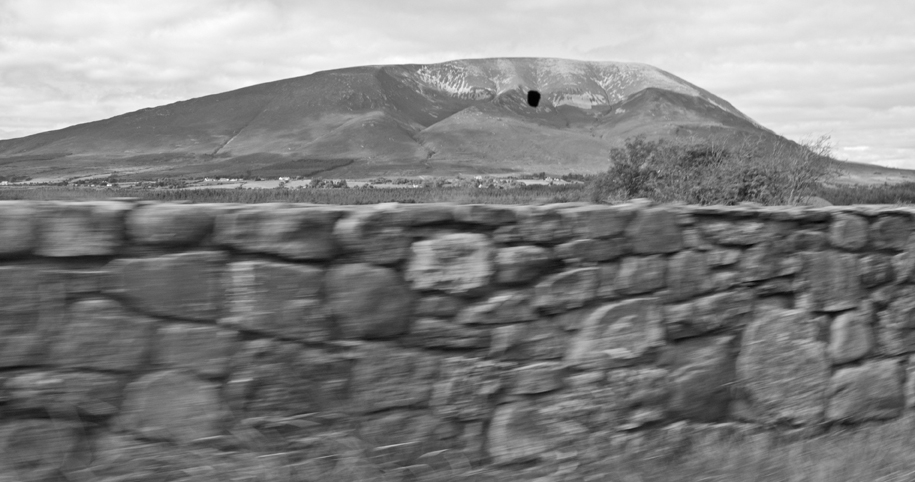Soviet filmmaker Dziga Vertov’s ‘kino-eye’ was a film montage method that could, as he saw it, show things in a way no human eye could see, and would elevate human consciousness. On the whole, film’s effect on humanity has largely gone the other way to Vertov’s prediction. But Niamh O’Malley has, for the past few years, produced a series of black-and-white videos that calmly survey a landscape, yet also slowly let what we’re seeing merge with how we’re seeing it – shadows conflate with the screen, blinking becomes linked with editing, the eye becomes the lens. We’ve already become, O’Malley seems to suggest, Vertov’s living kino-eye, editing and shaping things with every glance; we just habitually ignore the fact.
This latest exhibition is no different, with the video Nephin (2014) as its centrepiece, documenting a passenger-side view of a car journey circling a low, grass-covered mountain. The rounded landform stays centre-screen as we pass by houses and fields, with hedgerows occasionally blocking the view, but after a while, it’s likely that the only thing we’ll focus on is a small, black dot that persists on the upper right of the screen. Whether a speck on the car window or the camera lens, it’s a small but effective reminder of the limits to how we view the world. As a further reminder, two tall, framed panels of coloured glass, one pink and one yellow, flank the video screen, letting us view the scene in another hue.
It’s a point that this reserved and refined installation of 17 works of drawing, glass sculptures and two films continually reemphasises: that seeing is always layered, always filtered, always framed. Several drawings depict the same mountain, rock or mound of dirt, each presented behind a speckled pane of tinted glass. But it’s when O’Malley all but gives up on her chosen subject of landscape that her bio-structuralist meditations become more productive. The small Untitled (2014) is a dense weave of short, modest pencil marks, accumulating and almost merging with the lines and shadows projected by the pocked layer of glass that covers it. The real heart of the show feels tucked into a few hidden corners of the angular concrete gallery: Shelf (2014) is a small stretch of beech with three pieces of glass propped on top. Here, a roughly L-shaped shard of yellow glass is mirrored by a grey fragment that resembles it, though its dark brother is lined unevenly with copper. Both of them form a miniature stage for a rectangle of clear glass, smudged with a blotch of white paint; here, O’Malley distils her entire show in one small breath.
The two-screen video Glasshouse (2014) is ostensibly a slow pan across the broken and dirtied panes of a greenhouse, at first seeming like a widescreen panorama, our minds naturally connecting the two screens as the scene passes from right to left. It’s only after a concentrated few minutes that you can distinguish the stereoscopic effect and realise that the two screens aren’t linked, in some cases even showing the same stretch of the greenhouse. It’s in the small gap between the two monitors that the work takes hold, the darkness that allows our mind to invest in, and effectively create, a new unified image; and it’s in this gutter that O’Malley excels.
This article was first published in the March 2015 issue.
